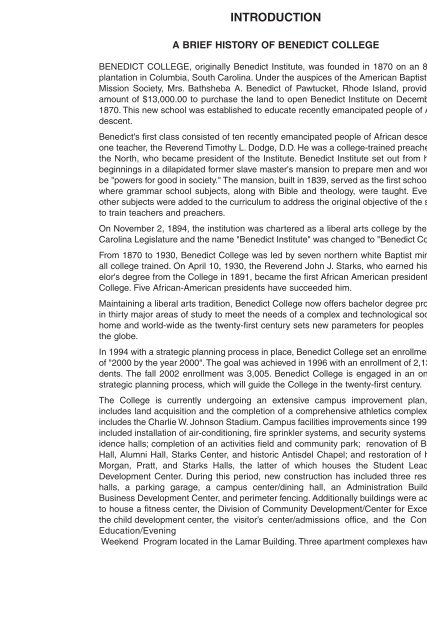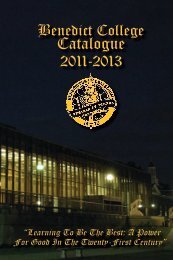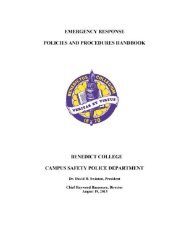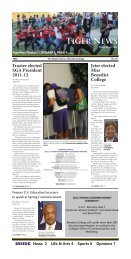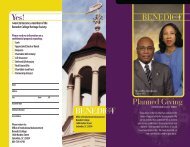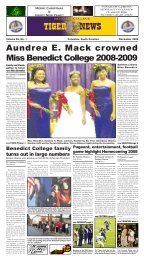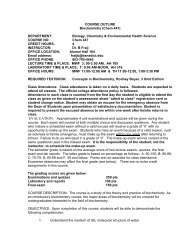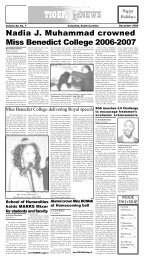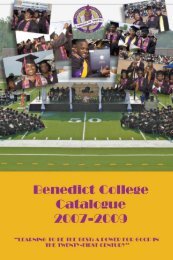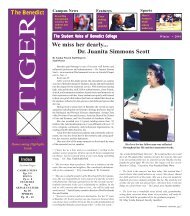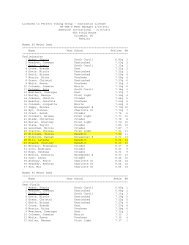2009-2011 - Benedict College
2009-2011 - Benedict College
2009-2011 - Benedict College
You also want an ePaper? Increase the reach of your titles
YUMPU automatically turns print PDFs into web optimized ePapers that Google loves.
23<br />
INTRODUCTION<br />
A BRIEF HISTORY OF BENEDICT COLLEGE<br />
BENEDICT COLLEGE, originally <strong>Benedict</strong> Institute, was founded in 1870 on an 80-acre<br />
plantation in Columbia, South Carolina. Under the auspices of the American Baptist Home<br />
Mission Society, Mrs. Bathsheba A. <strong>Benedict</strong> of Pawtucket, Rhode Island, provided the<br />
amount of $13,000.00 to purchase the land to open <strong>Benedict</strong> Institute on December 12,<br />
1870. This new school was established to educate recently emancipated people of African<br />
descent.<br />
<strong>Benedict</strong>'s first class consisted of ten recently emancipated people of African descent and<br />
one teacher, the Reverend Timothy L. Dodge, D.D. He was a college-trained preacher from<br />
the North, who became president of the Institute. <strong>Benedict</strong> Institute set out from humble<br />
beginnings in a dilapidated former slave master's mansion to prepare men and women to<br />
be "powers for good in society." The mansion, built in 1839, served as the first schoolhouse<br />
where grammar school subjects, along with Bible and theology, were taught. Eventually<br />
other subjects were added to the curriculum to address the original objective of the school:<br />
to train teachers and preachers.<br />
On November 2, 1894, the institution was chartered as a liberal arts college by the South<br />
Carolina Legislature and the name "<strong>Benedict</strong> Institute" was changed to "<strong>Benedict</strong> <strong>College</strong>."<br />
From 1870 to 1930, <strong>Benedict</strong> <strong>College</strong> was led by seven northern white Baptist ministers,<br />
all college trained. On April 10, 1930, the Reverend John J. Starks, who earned his bachelor's<br />
degree from the <strong>College</strong> in 1891, became the first African American president of the<br />
<strong>College</strong>. Five African-American presidents have succeeded him.<br />
Maintaining a liberal arts tradition, <strong>Benedict</strong> <strong>College</strong> now offers bachelor degree programs<br />
in thirty major areas of study to meet the needs of a complex and technological society at<br />
home and world-wide as the twenty-first century sets new parameters for peoples across<br />
the globe.<br />
In 1994 with a strategic planning process in place, <strong>Benedict</strong> <strong>College</strong> set an enrollment goal<br />
of "2000 by the year 2000". The goal was achieved in 1996 with an enrollment of 2,138 students.<br />
The fall 2002 enrollment was 3,005. <strong>Benedict</strong> <strong>College</strong> is engaged in an on-going<br />
strategic planning process, which will guide the <strong>College</strong> in the twenty-first century.<br />
The <strong>College</strong> is currently undergoing an extensive campus improvement plan, which<br />
includes land acquisition and the completion of a comprehensive athletics complex which<br />
includes the Charlie W. Johnson Stadium. Campus facilities improvements since 1994 have<br />
included installation of air-conditioning, fire sprinkler systems, and security systems in residence<br />
halls; completion of an activities field and community park; renovation of Bacoats<br />
Hall, Alumni Hall, Starks Center, and historic Antisdel Chapel; and restoration of historic<br />
Morgan, Pratt, and Starks Halls, the latter of which houses the Student Leadership<br />
Development Center. During this period, new construction has included three residence<br />
halls, a parking garage, a campus center/dining hall, an Administration Building, a<br />
Business Development Center, and perimeter fencing. Additionally buildings were acquired<br />
to house a fitness center, the Division of Community Development/Center for Excellence,<br />
the child development center, the visitor’s center/admissions office, and the Continuing<br />
Education/Evening<br />
and<br />
Weekend Program located in the Lamar Building. Three apartment complexes have been


